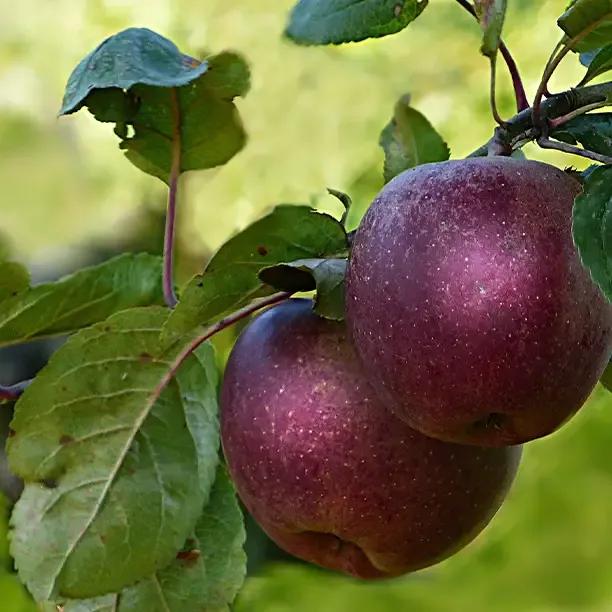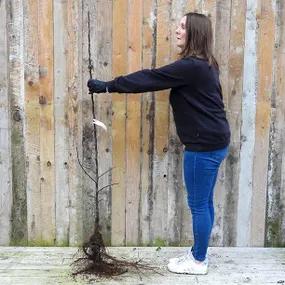Tickled Pink® Apple Trees
Honest Delivery Prices- Eating, Cooking & Juicing: Mild tart flavour
- Spur bearer
- Self sterile.
- Pollinator
- Pollination Group C.
- Harvesting: September - October.
- Stores 1 - 2 weeks.
Description
Tickled Pink® Apple Trees: Eating & Cooking
Fantastic dual-purpose apple with gorgeous deep red skins and unusual rosy red flesh: so ornamental and edible, you will want to have your apple and eat it too!
They are delicious eaten straight from the tree and are great all-rounders in the kitchen, keeping their lovely tart flavour and holding their shape when cooked. Their pink flesh looks stunning in pies and crumbles, and produces abundant pink juice.
The tree has exquisite carmine-pink blossom in spring, followed by the beautiful ruby red fruits in autumn, and the new leaves are purple red, giving you a dash of autumnal colour at the start of the growing season: perfect for planting where it can be admired.
Browse our range of apple trees or all our fruit trees.
Delivery season: Bareroot plants are delivered in late Autumn to Spring, about November-March inclusive.
Features:
- Dual-purpose eating, cooking and juicing.
- Rich red skin & pink flesh. Mild-tart flavour.
- Spur bearer (good for cordons & espaliers)
- Pollination Group C.
- Harvest September to October. Only stores for a couple of weeks
- Crimson blossom. Purple-red spring foliage.
- Good disease resistance
Growing Tickled Pink Apples
Apples like a rich, well drained soil, and will thrive on clay in locations that do not get waterlogged in winter.
A full day of sun and shelter from the wind is ideal.
Rootstocks:
We use MM106 for Tickled Pink, the UK standard for medium-sized trees, ideal for gardeners. It gives a half-standard about 4m tall, and a bush about 3m.
MM106 maidens are suitable for cordons and espaliers, but most of our ready-made cordons are on the less vigorous M9.
Disease notes:
Overall disease resistant, good resistance to scab.
Planting Instructions
How to plant Malus domestica Tickled Pink trees:
Bare root trees are available for planting in the dormant season, between November and March. Container grown plants can be bought all year round - although planting in winter is preferable.Apple trees like a sunny sheltered site with well drained soil. Dig a hole no deeper than the root ball but around three times the diameter. Dig over the bottom of the hole and add in some well rotted compost or manure, as well as dressing of Rootgrow mcycorrhizal fungi.. Place the tree in the hole and back fill with soil. Heel carefully in to place. Stake in the direction of the prevailing wind.
Keep well watered in dry weather and top dress with a general-purpose fertiliser in spring. Trained apples are pruned in summer, and standards in winter.
Spacing Tickled Pink apple trees:
Freestanding bushes: 12-18 feet (4-6 metres) between trees and rows.Freestanding half-standards: 18-30 feet (6-10 metres) between trees and rows.
In general, allow 1 more metre between rows than there is between each tree in the row.
Watch our video on how to plant a fruit tree for full instructions on planting a bush or half-standard sized tree.
If you are growing a maiden sized apple tree into a freestanding tree, a bamboo cane is enough support.
If you are growing a cordon or espalier, you will need to install training wires to support them.
Remember to water establishing apple trees during dry weather for at least a year after planting.
Apple Tree Planting Accessories:
For bush and half standard apple trees, our tree planting pack includes a wooden stake & rubber tie to support the tree and a biodegradable mulch mat with pegs, which protects the soil at the base of your tree from drying out and stops weeds from sprouting.After you plant an apple tree, the most important thing to do is water it in dry weather and weed around it. Both of these will be necessary for at least a year after planting. We recommend using a mulch mat as well.
The best tip for helping your tree to establish and quickly become mature and productive is to remove all the fruit that it produces in the first year after planting, as soon as the flowers fade. This will give the tree a chance to develop its roots, which are the foundation of the tree's strength, and sturdy branches that can bear the weight of a heavy crop without snapping.
All fruit trees will need formative pruning during their first years. Although this is not complicated, it is important to research and understand the process so that you can apply it to your particular tree and situation.
Harvesting Tickled Pink apples:
Your trees should crop September - October. Tickled Pink apples will store for a couple of weeks.
Read more about picking and storing apples here.
Hygiene & Diseases:
Dead, damaged or diseased wood can be pruned off as soon as it appears.
Disinfect your pruning tools between every cut if there is any sign of disease.
Burn or dispose of any diseased material, do not compost it.
Did You Know?
This German variety was bred from 'Weirouge' and released in 2009 by the Bayerisches Obstzentrum, Bavarian Fruit Centre, and is sold there as Baya® Marisa.
Only a year later, the 'Redlove' apple, bred in a totally different program by Markus Kobert for Lubera in Switzerland, was released after over two decades of pioneering work: too bad, Mr Kobert, better luck next time.
Still, neither of those fine varieties would have been the world's first red-fleshed apple, and that's not counting the pinkish Sops in Wine, or Bloody Ploughman. In Iran, Semnan Province's native apple has red flesh and roots, as well as red young bark and new leaves.
Known as the Bakran apple after a village in the area, it is credited with life-extending properties, and the power to attract tourists.
Apple Tree Delivery Shapes:
Most of our fruit trees are delivered in up to 3 shapes (maiden, bush, and half standard), and selected varieties as ready-made cordons and/or potted mini patio trees.
Maiden: This unbranched tree is the most basic starting size, which you can train into the other forms (apart from mini patio trees).
Cordon: Tickled Pink is a spur-bearer, suitable for cordons and espaliers.
Bush: A freestanding tree with a short trunk about 60cm tall. It will grow to about 3 metres tall. Ideal for small gardens.
Half-Standard: A freestanding form with a trunk about 120cm tall. It will grow into a full sized, "normal" apple tree, about 4 metres tall. Ideal for orchards, easy to mow underneath.
Mini Patio Tree: Only sold pot-grown, these use a dwarfing rootstock to drastically reduce the tree's vigour and restrict the
For more details, take a look at our Guide to Fruit Tree Sizing.



